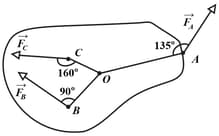In the given below figure shows an arrangement of Identical discs that have been glued together in a rod-like shape of length , and (total) mass . The discs are uniform, and the disc arrangement can rotate about a perpendicular axis through its central disc at point .
What is the rotational inertia of the arrangement about that axis?
If we approximated the arrangement as being a uniform rod of mass and length , what percentage error would we make in using the formula used to calculate the rotational inertia?



Important Questions on Rotation
In the given below figure two particles, each with mass , are fastened to each other, and to a rotation axis at , by two thin rods, each with length , and mass . The combination rotates around the rotation axis with the angular speed . Measured about what are the combination's rotational inertia and kinetic energy?
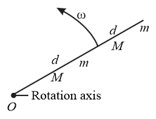
In the figure shown below, is an overhead view of a rod of length and mass that is lying stationary on a frictionless surface when three bullets hit it simultaneously. The bullets move along paths that are in the plane of the rod and perpendicular to the rod. Bullet has mass and speed . Bullet has mass has and speed . Bullet has mass and speed . The labelled distances are , and As a result of the impacts, the rod-bullets system rotates around its centre of mass while the centre of mass moves in a straight line over the frictionless surface. (a) What is the linear speed of the system's centre of mass?
(b) What is the distance between the rod's centre and the system's centre of mass?
(c) What is the rotational inertia of the system about the system's centre of mass?
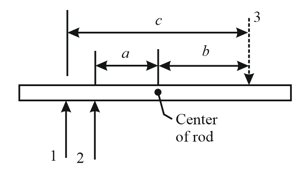
The uniform solid block in the figure shown below has mass and edge lengths and . Calculate its rotational inertia about an axis through one corner and perpendicular to the large faces.

Four identical particles of mass each are placed at the vertices of a square and held there by four massless rods, which form the sides of the square. What is the rotational inertia of this rigid body about an axis that passes through the midpoints of opposite sides and lies in the plane of the square, passes through the midpoint of one of the sides and is perpendicular to the plane of the square, and lies in the plane of the square and passes through two diagonally opposite particles?
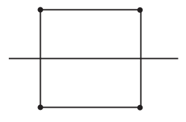
The body in the given below figure is pivoted at and two forces act on it as shown. If , and , what is the net torque about the pivot?
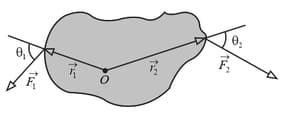
The body in the figure shown below is pivoted at . Three forces act on it,
at the point from ,
at the point from and
at the point from .
What is the net torque about ?
